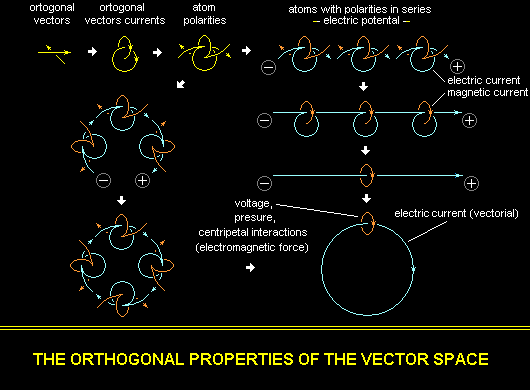Ohm's
Law
The vectorial space explains the nature of the relations between
tension, current and resistance from an electric circuit.
The nucleon, a hydrogen atom, is composed of two vectorial currents that
are identical and orthogonal.
Thus, any of the two currents can be electric or magnetic.
These currents have each their own vectorial polarities and present orthogonal
simetry.
When more atoms gather their polarities in series of one of the two currents,
an electric potential is formed with positive and negative terminals.
The remaining orthogonal currents are now magnetic currents - magnetic
polarities.
If we connect the terminals of the potential with a conductor, the circuit
will be closed.
When a circuit is closed, the two currents, electric and magnetic,
are producing centripetal vectorial interactions, tension and current,
which is propagated in the whole circuit with the speed of light.
The propagation is produced simultaneously from both terminals, from plus
to minus and the other way around.
The resistance
The propagation medium of a centripetal interaction, are the polarities
of the atoms
with orthogonal symmetry, within the structure of the conductor - conductivity.
The atoms without orthogonal symmetry, are deviating the magnetic and
electric currents propagation direction
and generate Foucault currents - resistivity.
The thermal effect
The centripetal interactions are producing thermal effects
on the atoms with a deficit in orthogonal symmetry within the structure
of the conductor.
In these structure, are produced avalanches of centripetal interactions
to the atomic bond level, which emit radiations up to state transformations
(plasma).
These effects are currently interpreted as "friction and clashes
"phenomena.
It is true that the mechanical interactions as friction, bending, tearing
etc.
are producing centripetal vectorial interactions at the atomic bond level
and emit radiations.


